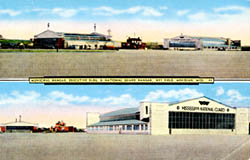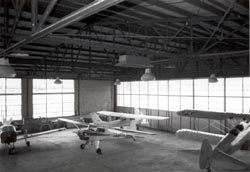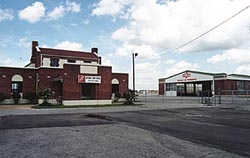
The Old Terminal Building, Hangar and Powerhouse at Key Field form the earliest surviving airport complex in the state of Mississippi. Key Field (originally the Meridian Regional Airport) opened in November of 1930 with the completion of the Terminal, Hangar, Powerhouse and a graded and packed dirt runway. It was run by brothers Algene and Frederick Key, pioneers of aviation who established and still retain the flight endurance world record. Algene and Frederick also operated the Key Brothers' Flying School at Bonita Field several miles outside Meridian. With the onset of the Great Depression, the City of Meridian considered abandoning the airport because of the cost of maintenance. However, the Key brothers devised a scheme to keep the airport operating. They hoped that by breaking the standing flight endurance record of 23 days they would focus worldwide attention on Meridian and its airport.
To accomplish this feat they modified a small single-engine Curtis Robin airplane, which they named the Ole Miss, by adding an extra 150-gallon fuel tank and a catwalk for mid-flight repairs and refueling. The plane's seats were removed to provide room for the tank, and a new pilot's seat was built into the forward end of the tank. When off duty, one of the brothers could crawl over the tank to the rear luggage compartment, which housed a thin mattress. In the 1930s, air-to-air refueling was still a dramatic and dangerous innovation. It had been done on other endurance flights, but if gasoline from the hose spattered the exhaust area during refueling, the gas would ignite. To avoid that possibility, a Meridian mechanic, A.D. Hunter, designed an automatic cutoff valve for the hose nozzle. James Keeton, one of Al Key's students, piloted the refueling airplane and Bill Ward was in charge of lowering the fuel hose and supplies to the endurance airplane. To solve the problem of communications, the Keys had Ben Woodruff, a local radio repairman and part-time inventor, build and install a two-way radio in the airplane that needed batteries and a wind-driven generator. This was the first use of a very high frequency (VHF) air-to-ground and ground-to-air radio outfit, which is now the most popular band for aviation communication and navigation.

After two unsuccessful attempts to break the record, the brothers launched their third attempt on June 4, 1935. They flew a figure eight pattern over Meridian, and as their time aloft mounted, the flight attracted worldwide attention. On July 1, the Key brothers landed at the Meridian airport to a cheering crowd of about 35,000 people after completing 27 days in flight. They had flown nonstop for more than 52,000 miles (a distance roughly equal to twice around the world) in 653 hours, 34 minutes. To date, no airplane has beaten that record. Not until NASA's Skylab II mission in 1973 did man stay above earth longer than the Keys, but the brothers' intra-atmospheric flight record has not been broken for the class of aircraft they flew. Upon breaking the endurance record, the airport was renamed Key Field in the brothers' honor.
The Key brothers later served as bomber pilots in the Pacific theater during World War II. Fred was awarded the Distinguished Flying Cross, and Al earned a Distinguished Flying Cross, a Distinguished Service Cross, an Air medal, a British Distinguished Service Cross and seven bronze stars for participating in combat. They both had distinguished careers--Al remained in the Air Force until his retirement in 1960 at the rank of full Colonel and Fred ran the Key Brothers Flying Service at Key Field until his death in 1971. The cutoff valve developed for the Keys by A.D. Hunter was an important innovation for national defense, being the precursor of those used by modern tanker airplanes that keep bombers and fighters in the air. Today, with only slight modifications, U.S. Air Force and Strategic Air Command airplanes use the valve that Hunter invented.

Facing east toward the highway, the Old Terminal is a two-story, brick building with single-story, one-by-one bay, front entrance pavilion and side wings. To the north of the Terminal is the Hangar, a large, rectangular, brick building resting on a concrete foundation and crowned by an asbestos-clad gable roof with parapeted end walls. The Hangar was built to accommodate 10 airplanes, which gain access through either the south or north end through eight large sliding metal doors. On the east side of the Hangar is the diminutive brick Powerhouse. The one-story, one-by-one bay building has a gable roof with parapeted end walls with concrete copings.
Visit the National Park Service Travel American Aviation to learn more about Aviation related Historic Sites.
Last updated: September 3, 2017
